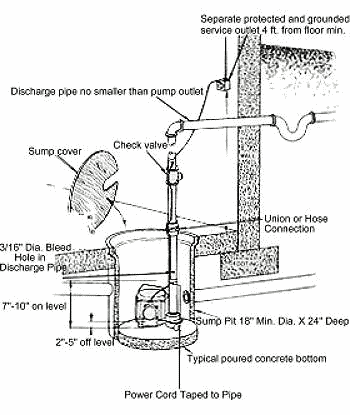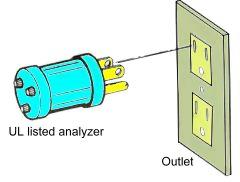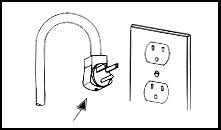| SAFETY GUIDELINESREAD ALL INSTRUCTIONS AND SAFETY GUIDELINES SUPPLIED WITH YOUR PUMP THOROUGHLY. FAILURE TO FOLLOW THE GUIDELINES AND INSTRUCTIONS COULD RESULT IN SERIOUS BODILY INJURY AND/OR PROPERTY DAMAGE. |
| |
| 1. |
CAUTION: To reduce the risk of electrical shock, pull plug before servicing any pump. |
| |
| 2. |
Check local electrical and building codes before installation. The installation must be in accordance with their regulations. |
| |
| 3. |
During normal operation the sump pump is immersed in water. Also, during rain storms, water may be present in the surrounding area of the pump. Caution must be used to prevent bodily injury when working near the pump. |
|
| |
| |
a. |
Electrical power should be disconnected prior to touching, servicing or repairing the pump. |
| |
| |
b. |
To minimize possible fatal electrical shock, hazard, extreme care should be used when changing fuses. Do not stand in water while changing fuses or insert your finger into the fuse socket. |
| |
| 4. |
Do not run the pump in a dry sump. If the pump is run in a dry sump, the surface temperature of the pump will rise to a high level. This high level could cause skin burns if the pump is touched and will cause serious damage to your pump. |
| |
| 5. |
Unless you manufacturers instructions say to do so, do not oil the motor. The pump housing in most sump pumps is sealed with a high grade dielectric oil devoid of water inside. Use of other oil could cause serious electric shock and or permanent damage to the pump. |
| |
| 6. |
If your pump's motor housing is filled with a dielectric lubricant at the factory. It is there for optimum heat transfer and lifetime lubrication of the bearings. Use of any other lubricant could cause damage and void your warranty. This lubricant is non-toxic; however, if it escapes the motor housing, it should be removed from the surface quickly by placing newspapers or other absorbent material on the water surface to soak it up, so aquatic life is undisturbed. |
| |
| 7. |
In any installation where property damage and/or personal injury might result from an inoperative or leaking pump due to power outages, discharge line blockage, or any other reason, a backup system(s) and/or alarm should be used. |
| |
 |
| |
| WARNINGRisk of electric shock- most sump pumps are supplied with a grounding conductor and grounding-type attachment plug. To reduce the risk of electric shock, be certain that it is connected only to a properly grounded, grounding-type receptacle. As a safety measure, each electrical outlet should be checked with an Underwriters Laboratory Listed circuit analyzer. This will indicate if the power, neutral and ground wires are properly connected. If they are not, call a qualified licensed electrician. |
 |
| |
| WARNING
If your sump pump is supplied with a 3-prong electrical plug. The third prong is to ground the pump to prevent possible electric shock hazard. Do not remove the third prong from the plug. A separate branch electrical circuit is recommended. Do not use an extension cord. |
 |
|
|
| INSTALLATION |
| |
| 1. |
Clean any debris from sump pit and and set pump in center of pit. A solid bottom will prevent clogging of the pump from sand and dirt. |
| |
| 2. |
Connect discharge piping and run it to the nearest sewer or surface outlet. Use pipe joint compound at all connections. Sump pumps can be piped to discharge into the house drainage system, to a dry well, splash block or to a storm drain, depending on local plumbing codes. The discharge pipe should be as short as possible and contain as few elbows as possible. The discharge pipe should be the same diameter as the discharge size to reduce pipe friction losses. Smaller pipe will restrict capacity and reduce pump performance. |
| |
| 3. |
Always install a union in the discharge line, just above the sump pit to allow for easy removal of the pump for cleaning or repair. |
| |
| 4. |
In situations where piping is long, vertical discharge is above 7 or 8 feet, or a small pit has been provided, use of a check valve is recommended to prevent backflow of water into the sump. When a check valve is used, drill a relief hole(1/8 or 3/16" diameter) in the discharge pipe. This hole should be located below the floor line between the pump discharge and the check valve. Unless such a relief hole is provided, the pump could air lock and will not pump water even though it will run. |
| |
| 5. |
Tape pump and switch cords to discharge line with electrician's tape. This will protect the cord from damage and will prevent the power cords from interfering with float. |
| |
| 6. |
TEST THE PUMP AFTER ALL CONNECTIONS HAVE BEEN MADE. Run water into the sump. Do not attempt to operate the pump without water; this will damage the seals and bearings and could result in permanent damage to the pump. Fill sump to normal on level and allow pump to remove to the normal off level |
| |
| 7. |
Place cover over sump. This cover will prevent solid debris from filling the pit, prevent odors, and guard against accidental injury. |
| |
| WARNING: Always disconnect the electrical power before touching the pump or discharge when water is present in the sump. Failure to do so can result in hazardous electrical shock. |
|
We have free shipping and great prices.
We keep sump pumps in stock and will provide you with tracking information by email when you order ships (usually the same business day of your order).
6 CIA (8 ft cord)
5 ASP LL
6E CIA RFSN
8 CIA (25 ft cord)
whole range
|
|
